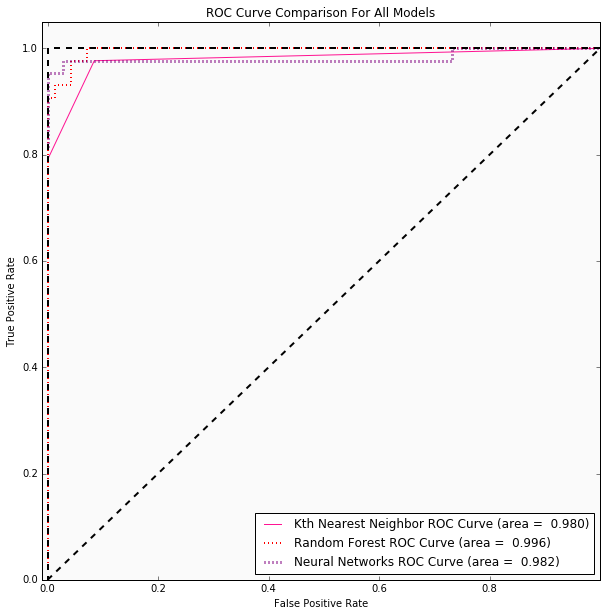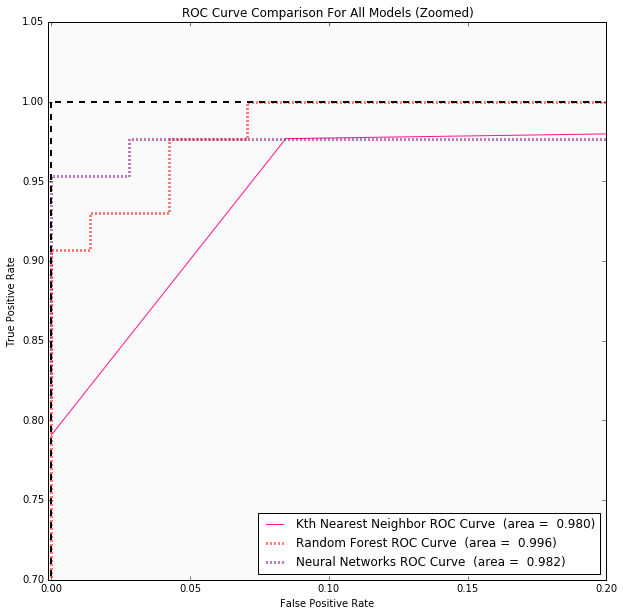Contributor:
- Raul Eulogio
I created this repo as a way to get better acquainted with Python as a language and as a tool for data analysis. But it eventually became in exercise in utilizing various programming languages for machine learning applications.
I employed four Machine Learning techniques:
- Kth Nearest Neighbor
- Random Forest
- Neural Networks:
If you would like to see a walk through of the analysis on inertia7 includes running code as well as explanations for exploratory analysis. This project contains an overview of random forest, explanations for other algorithms in the works.
The repository includes the scripts folder which contains scripts for these programming languages (in order of most detailed):
- Python
- R
- PySpark
This repo is primarily concerned with the python iteration.
The multiple python script is broken into 5 sections (done by creating a script for each section) in the following order:
- Exploratory Analysis
- Kth Nearest Neighbors
- Random Forest
- Neural Networks
- Comparing Models
NOTE: The files data_extraction.py, helper_functions.py, and produce_model_metrics.py are used to abstract functions to make code easier to read. These files do a lot of the work so if you are interested in how the scripts work definitely check them out.
A virtualenv is needed where you will download the necessary packages from the requirements.txt using:
pip3 install -r requirements.txt
Once this is done you can run the scripts using the usual terminal command:
$ python3 exploratory_analysis.py
NOTE: You can also run it by making script executable as such:
$ chmod +x exploratory_analysis.py
Remember: You must have a shebang for this to run i.e. this must be at the very beginning of your script:
#!/usr/bin/env python3
then you would simply just run it (I'll use Random Forest as an example)
$ ./random_forest.py
Once I employed all these methods, we were able to utilize various machine learning metrics. Each model provided valuable insight. Kth Nearest Neighbor helped create a baseline model to compare the more complex models. Random forest helps us see what variables were important in the bootstrapped decision trees. And Neural Networks provided minimal false negatives which results in false negatives. In this context it can mean death.
| Model/Algorithm | Test Error Rate | False Negative for Test Set | Area under the Curve for ROC | Cross Validation Score | Hyperparameter Optimization |
|---|---|---|---|---|---|
| Kth Nearest Neighbor | 0.07 | 5 | 0.980 | Accuracy: 0.925 (+/- 0.025) | Optimal K is 3 |
| Random Forest | 0.035 | 3 | 0.996 | Accuracy: 0.963 (+/- 0.013) | {'max_features': 'log2', 'max_depth': 3, 'bootstrap': True, 'criterion': 'gini'} |
| Neural Networks | 0.035 | 1 | 0.982 | Accuracy: 0.967 (+/- 0.011) | {'hidden_layer_sizes': 12, 'activation': 'tanh', 'learning_rate_init': 0.05} |
The ROC Curves are more telling of Random Forest being a better model for predicting.
Any feedback is welcomed!
Things to do:
- Create Jupyter Notebook for KNN and NN (1/25/2018)
- Unit test scripts

